[OVD][VLM][KD] RKD: Bridging the Gap between Object and Image-level Representations for Open-Vocabulary Detection
[OVD][VLM][KD] RKD: Bridging the Gap between Object and Image-level Representations for Open-Vocabulary Detection
- paper: https://arxiv.org/pdf/2207.03482.pdf
- github: https://github.com/hanoonaR/object-centric-ovd
- NeurIPS 2022 accpeted (인용수: 92회, ‘24-03-17 기준)
- downstream task: Open Vocabulary Object Detection
1. Motivation
-
기존에 Open Vocabulary Object Detection은 두 가지 유명한 방식으로 vocabulary를 확장시켰음
-
pretrained CLIP이용: image-text pair를 기반으로 학습하다 보니, 정확한 object localization 을 예측할 수 없음
-
image-level (weak) supervision: object의 영역을 정확히 localize할 수 없었음

$ \to$ (1) pretrained CLIP embedding을 object-centric alignment수행하고, (2) pseudo labeling을 통해 image-level 에서 object-level supervision으로 image-level과 object level representation 간의 gap을 bridging 할 수 있지 않을까?
-
2. Contribution
- Image-centric CLIP embedding을 region-based embedding으로 alignment시키는 Region-based Knowledge Distillation (RKD)을 제안함
- High-quality object proposal을 만드는 Multi-modal ViT (MViT)를 활용하여 image-level image에 pseudo-labeling을 적용함
- 위 두가지 (vision-based)뿐 아니라, language domain에도 region-based alignment을 적용하기 위해 weight transfer function을 도입
- OVD benchmark에서 SOTA
3. RKD
-
preliminaries
-
Detector: 2-stage detector의 classifier head를 fixed language embedding으로 대체
-
fixed language embedding: CLIP text encoder에 “a photo of [CLS]”로 입력하여 생성
-
region-based embedding: RPN-RoI layer를 통과시킨 후, text embedding과 align하기 위해 linear layer f 까지 통과시켜 생성

- r: RPN에서 예측한 proposals
- $\phi$: RoI head
- f: CLIP text embedding과 align하기 위해 필요한 FC layer
-
-
Classification : text & region embedding간의 cosine similarity score

- $C_B$: Base class
- $T_b$: Base class text embedding
- R: region-based (visual) embedding
-
Total Loss

-
-
overall diagram
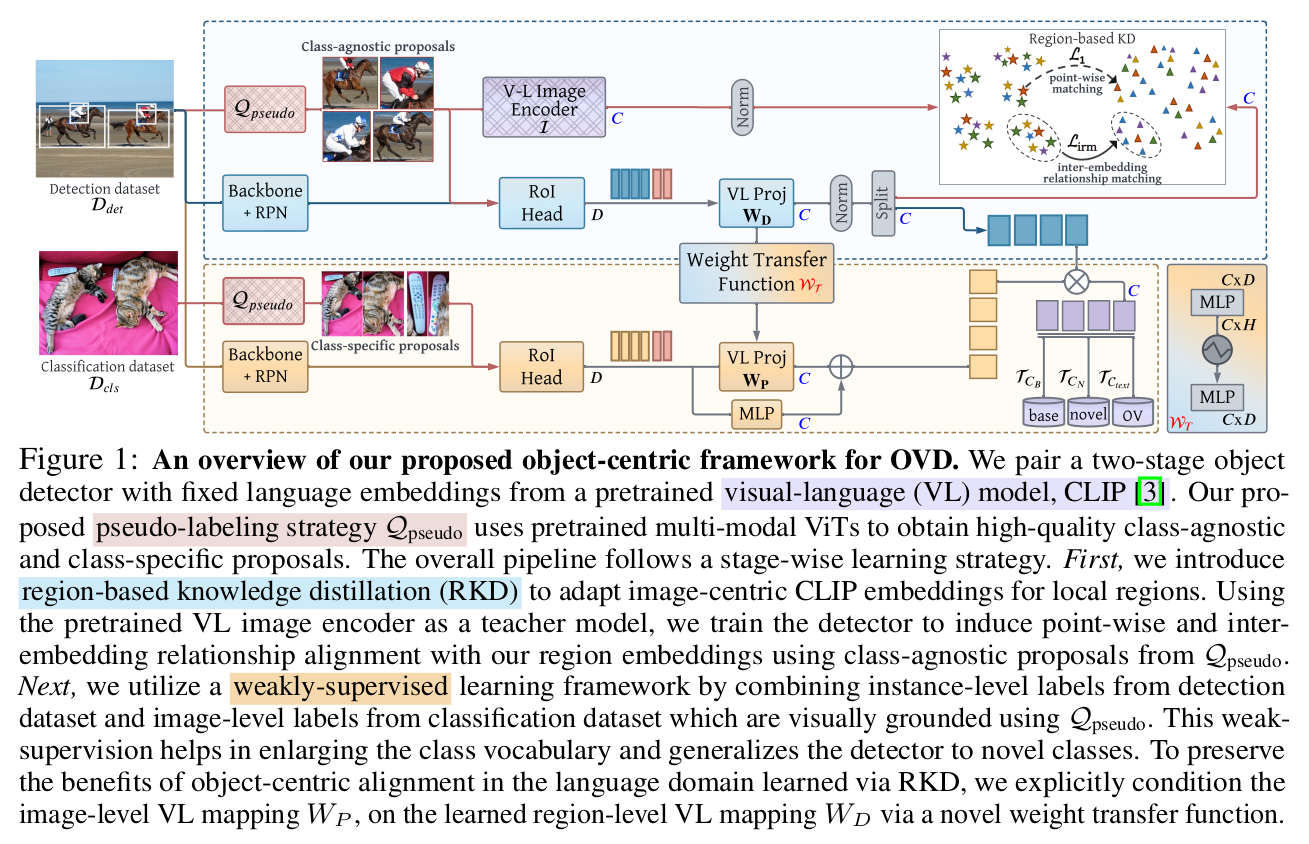
-
Pseudo Label
-
MViT기반 high-quality psuedo label을 class-agnostic (“all objects”), class-specific (“every [CLS]”)를 이용하여 CLIP embedding object proposal $\tilde{r}$과 함께 pseudo label을 예측
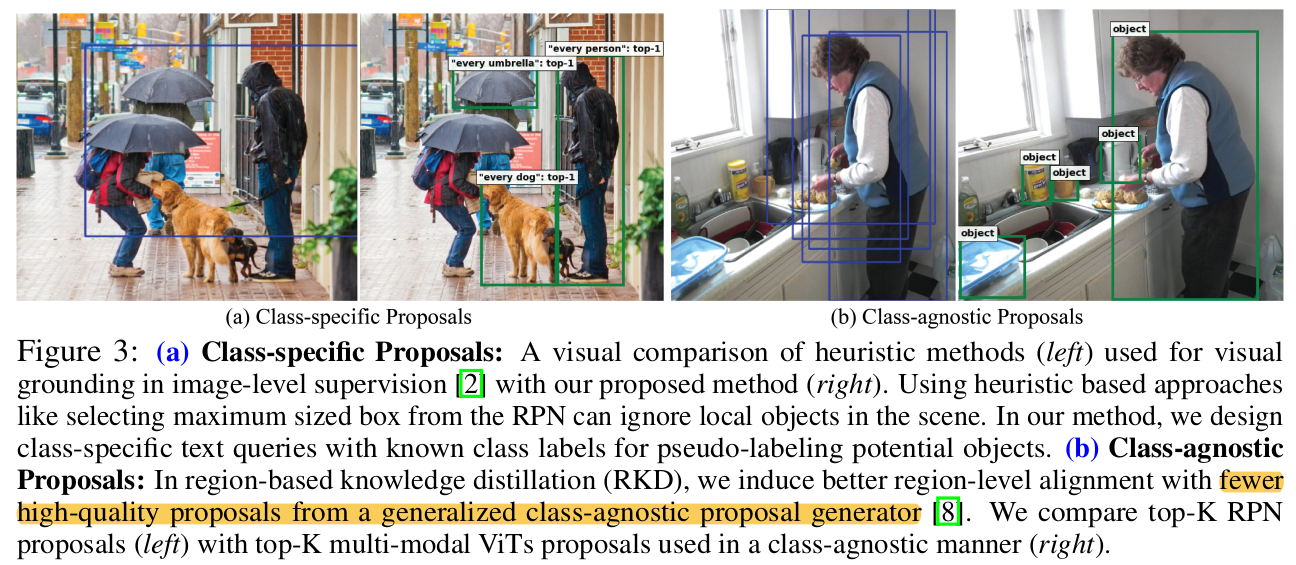
(a) 좌: RPN의 max-box를 이용한 pseudo label / 우: MViT의 class-agnostic Top-K pseudo label
- Detection dataset의 pseudo label로 활용 (localization 성능 향상)
- 학습의 효율성을 위해 모든 image에 대한 top-k CLIP embedding을 offline으로 미리 만들어 놓고 (offline) 학습 진행
(b) 좌: RPN의 Top-K pseudo label / 우: MViT의 class-specific Top-K pseudo label
- Classification dataset의 pseudo label로 활용 (classification 성능 향상)
- localization loss는 활용하지 않음
- Detection dataset의 pseudo label로 활용 (localization 성능 향상)
-
-
Region-based Knowledge Distillation
-
두 가지 loss를 이용
-
Point-wise embedding matching loss
-
CLIP region representation $I(\tilde{r})$와 region embedding $\tilde{R}=f(\phi(\tilde{r}))$간의 $L_1$ loss

$\to$ visual encoder (detector’s feature extractor)가 CLIP의 text embedding과 Align되도록 학습
$\to$ CLIP의 image encoder는 freeze시킬 것으로 예상
-
-
Inter-embedding relationship matching loss (IRM)
-
teacher (CLIP image encoder)와 student (our detector)는 학습방식이 다르므로, 두 예측값이 다른 경향을 나타냄
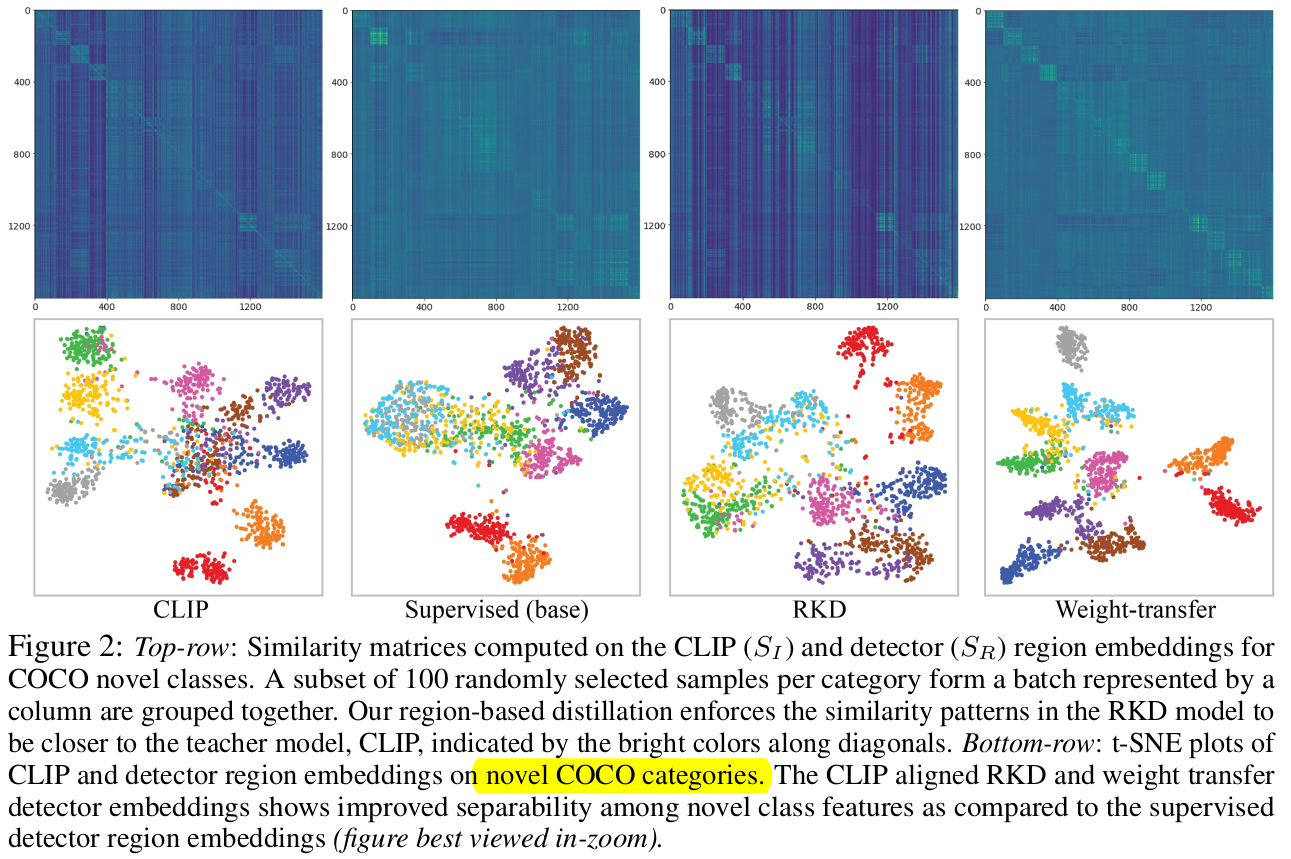
-
Top-K proposal에 대한 similarity matrix를 normalize시켜 IRM Loss를 계산

-
-
-
RKD Loss

-
-
Image-level supervision (ILS) with Pseudo Box Labels
-
pretrained MViT를 사용해서 class별 top-K pseudo label 중, class별 top-1 pseudo label만 필터링해서 사용


-
Pseudo Max Score (PMS) Loss

-
Image-Level Supervision (ILS) Loss

-
-
Weight Transfer Function
-
위 두가지 방식 (RKD+ILS)를 Naive하게 사용하면 text-embedding에 대해 학습이 안되므로 sub-optimal하게 학습됨

-
Language domain에도 object-centric alignment를 부여하기 위해 SAM에서 사용한 Weight Transfer방식을 도입

- $W_T$: 2-Layer MLP weight transfer function (learnable)
- $\theta_1, \theta_2$: learnable weights for 1st, 2nd layers
- $W_D$: RKD의 f projection layer (frozen)
- $\rho$: leaky-ReLu w/ 0.1 for negative slope
- $W_P$: weak image level supervision weights
- $W_T$: 2-Layer MLP weight transfer function (learnable)
-
Total Loss

-
4. Experiments
-
Datasets

- COCO OVD
- ZS OD에서 구현한 setting 활용
- base : 48 class
- novel : 32 class 중 17 class만 선택
- ZS OD에서 구현한 setting 활용
- LVIS OVD
- base: common, frequent class (866/1203 class)
- novel: rare class (337/1203 class)
- Cross-transfer Datasets
- Domain Generalization (unseen domain)
- Source: LVIS
- Target: OpenImages, Objects365, COCO
- Domain Generalization (unseen domain)
- COCO OVD
- Object Detection
- Res50+Faster-RCNN을 사용
-
Ablation

-
RKD 분석
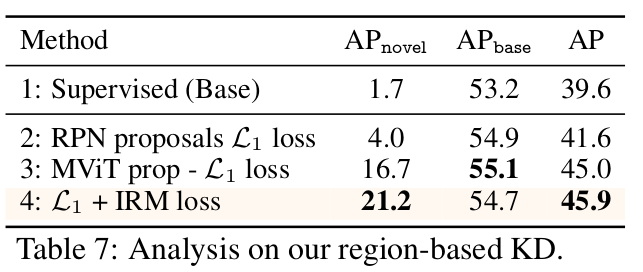
(2vs3) Pseudo Labeling RPN vs. MViT
(3vs4) IRM loss
-
ILS 분석
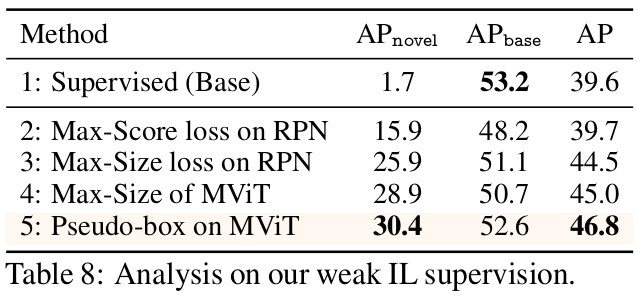
(2,3,4vs5) Pseudo Labeling previous vs. MViT
-
-
Open Vocabulary Evaluation
-
COCO
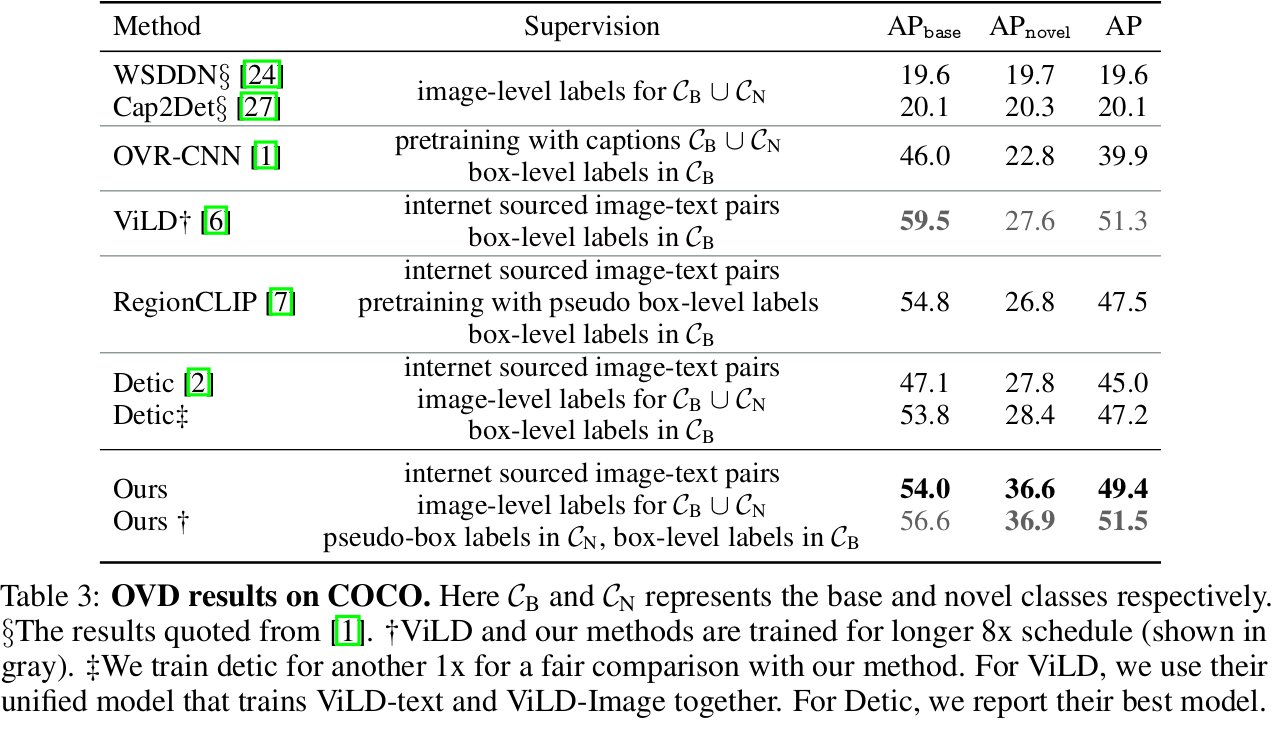
-
LVIS

-
-
Strict OVD setting
-
target class (open vocabulary) 가 unknown인 환경
-
Random하게 ImageNet-21K class 중 일부만 기존대비 vocab. size를 5배 증가시켜 novel/base class로 ILS 학습에 사용
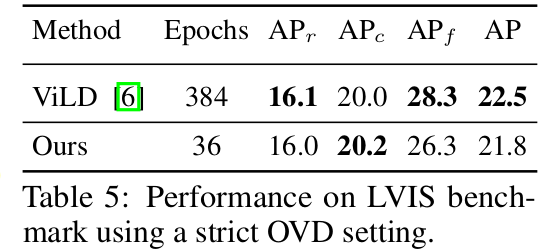
- Table4에 의거, 학습 epoch을 늘리면 성능 향상이 될거라 예측
-
-
Cross-Dataset (DG)

-
Qualitative Result
-
COCO and LVIS

-
Cross-Dataset
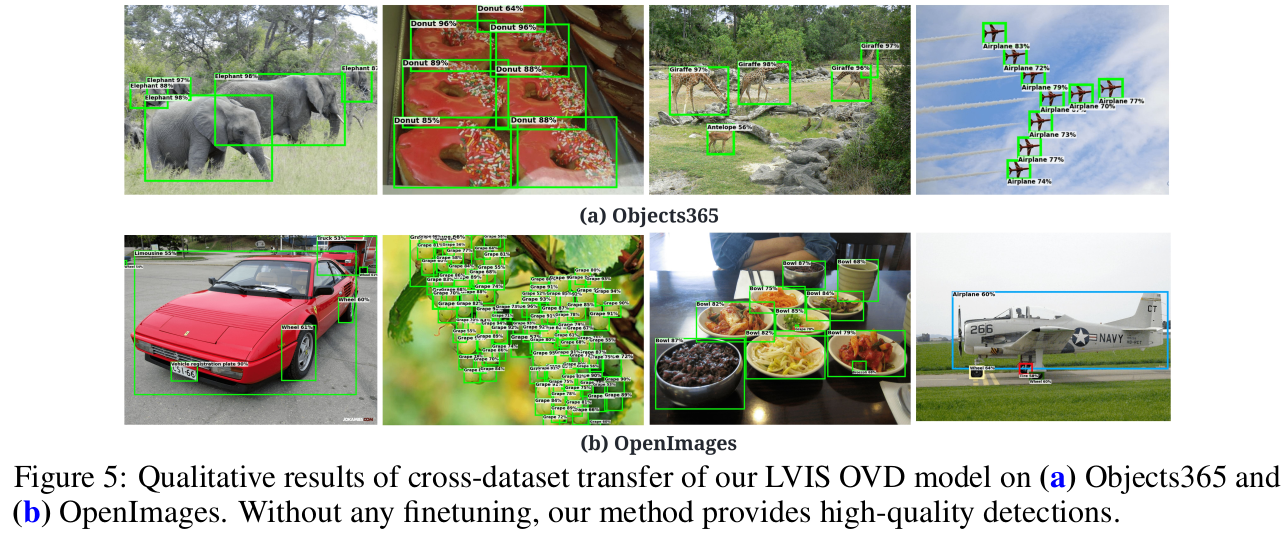
-